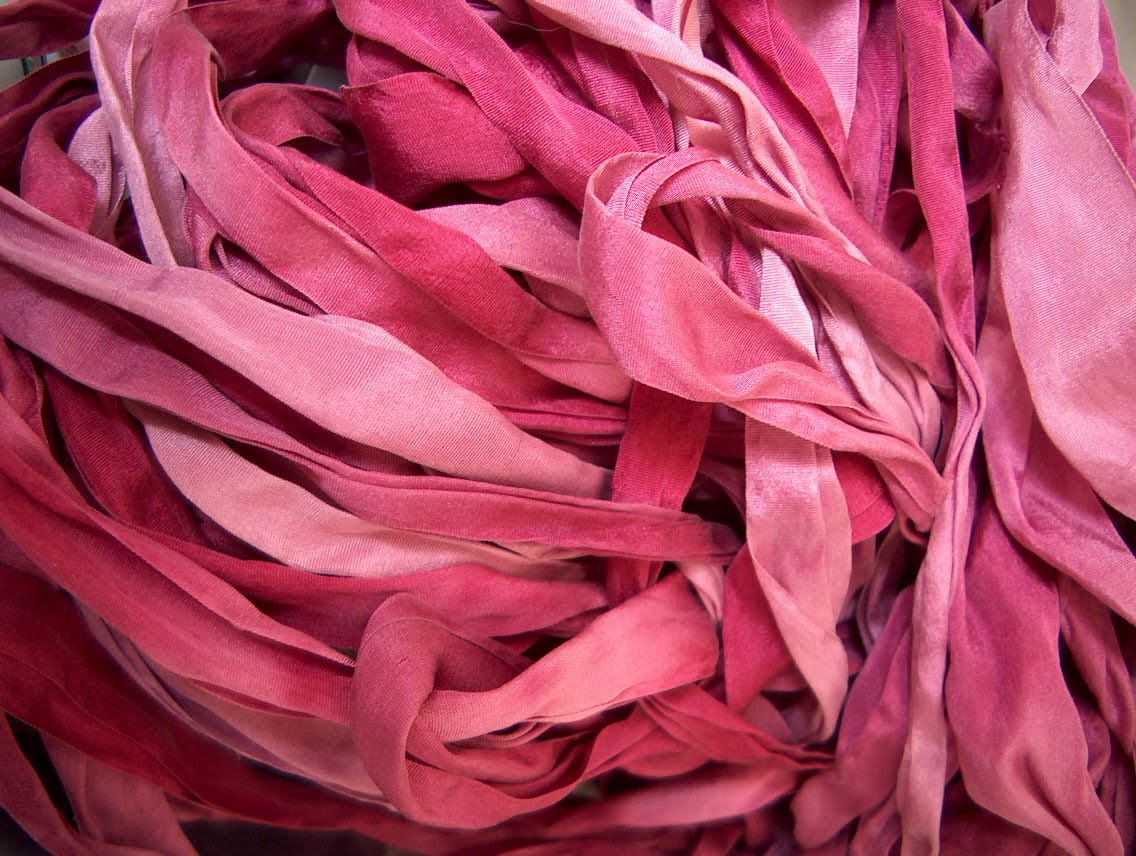Rust Dyeing by Kimberly Baxter Packwood © 2001
Rust dyeing is a surface design method that adds dimension to your fabrics and fibers. I use the technique predominately on cotton or silk fabrics. Natural fibers take the rust colors better than synthetic fibers.
You can rust dye onto commercially dyed and/or printed fabrics. However, fabrics dyed using synthetic dyes, or those dyed with natural dyes take rust dyeing best as they usually do not have anti-stain coatings on them.
When applying rusty objects to naturally dyed fabrics the colors will change. Iron, i.e. rust, is a modifier and is used as a mordant with natural dyes.
Modifiers change the existing color via shifts in the pH levels. An example would be hibiscus or cochineal, each yield a red color, when you add iron they shift from red to purple. A minute amount causes this color change.
You can place rusty objects next to wet fabric and acquire rust patterning over time. However, vinegar will speed up the rusting process, it aids in breaking the rust particles free from the object that is rusting.
Rusting occurs normally due to oxidation, i.e. contact with the air. Be patient. Rust dyeing with water takes about a week. Using vinegar produces color in less time usually twenty-four hours.
I use straight vinegar and all sorts of rusty objects to acquire my rust dyed patterns. Old nails and wire work well for this technique. Wire can be used for bound resist techniques, especially when wrapping the fabric around a rusty pipe. Or you can simply lay the wire in a loose pattern on the fabric and rust it in that manner.
Pole wrapping and bound resist techniques work well with rust dyeing. Simply wrap your vinegar-saturated fabric around a rusty pole, being careful not to tear the fabric, scrunch and otherwise manipulate the fabric to created patterning.
You can sprinkle iron mordant or iron shavings onto your fabric for other patterning. Iron mordant is preferable to shavings. Shavings are often sharp things that can cut you or the fabric. Metal shavings may be coated in machinery oil which would put unwanted stains onto the fabric.
If you like your rusty pieces and want to push the rust dyeing technique further, rinse the fabric and neutralize it in salt water, rinse it again and then rust the fabric once more. This will help prevent the fabric from rotting through.
Natural rust is an iron oxide. It comes in about ten or more natural colors depending on what it is in the neighboring the iron ore. Wear gloves and a mask when working with it.
You can mix a small amount natural rust with water, I generally use one teaspoon rust to one cup liquid, or with soy milk to paint fabric. Stir well. Let it sit for 24 hours to ensure that all of the color will dissolve. Then apply the rust solution to the fabric. Use a old brush you can dedicate to this kind of project. Natural bristle brushes work best with this technique allowing the liquid to wick up the bristles and not leave a mess on your fabric. Cure the fabric dry for 24 hours. Rinse and neutralize your fabric in a saltwater solution.
When using the rust technique if you want the process to stop you need to neutralize it with a salt-water solution. Dissolve about 1/4 cup salt into four gallons of hot water. I do this in a five-gallon bucket. Soak your fabric in the salt water about fifteen minutes. Wash the fabric using a non-phosphorous soap or a mild color free shampoo.
I teach workshops on rust dyeing, several workshops on natural dyeing and several for clay/pigment dyeing
- Kimberly
Natural Dyes, Workshops, Books and Hand-Dyed Fabrics, Yarns and more http://www.prairiefibers.blogspot.com Fiber Art & Art Quilts
To purchase "The Rust and Clay Dyeing Book" http://www.kbaxterpackwood.etsy.com

3 comments:
Thank you for this entry. I have gathered all of my grandfather's tools (and I'm over 50) and was planning to derust them all. After reading this entry and visiting your other sites I think now I will do a quilt tribute to him via rusting his tools on calico before cleaning them up.
Shirley
Thank you for this tutorial. Can you tell me how much cost your book and where I can find it?
Thank you,
Liana
Thank you for all this, I've been told by Jo Budd a British Textile artist that to get a good result with rust its best to rub down the iron and remove all the rust before wetting and applying fabric. Have you tried this?
Post a Comment